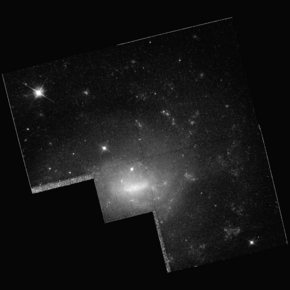NGC 5774
| NGC 5774 | |
|---|---|
 NGC 5774 (NASA/ESA HST) | |
| Observation data (J2000.0 epoch) | |
| Constellation | Virgo |
| Right ascension | 14h 53m 42.46s [1] |
| Declination | +03° 34′ 56.96″ [1] |
| Redshift | 0.005187 [1] |
| Heliocentric radial velocity | 1555 ± 2 km/s [1] |
| Distance | 71 Mly[1] |
| Apparent magnitude (V) | 12.30 [2] |
| Apparent magnitude (B) | 13.00 [2] |
| Characteristics | |
| Type | SAB(rs)d [1] |
| Apparent size (V) | 1.9 x 1.12 [1] |
| Other designations | |
| PGC 53231, MCG 1-38-13, UGC 9576 | |
NGC 5774 is an intermediate spiral galaxy approximately 71 million light-years away from Earth in the constellation of Virgo.[1] It was discovered by Irish engineer Bindon Stoney on April 26, 1851.[3]
NGC 5774 belongs to the NGC 5775 Group of galaxies—together with nearby NGC 5775, IC 1070, and others—which is part of the Virgo III Groups strung out to the east of the Virgo Supercluster of galaxies.[4][5] It has been classified as a "low surface brightness" (LSB) galaxy, but its central surface brightness is 5 times brighter than the brightest LSB galaxies.[5][6] It has a multiple spiral pattern with bright blue knotty structure all along the arms.[7]
It is an extremely low star forming galaxy with five X-ray sources plus three ultraluminous X-ray source candidates.[8]
Interaction with NGC 5775
[edit]NGC 5774 is interacting with the nearby spiral galaxy NGC 5775 in the form of two connecting H I bridges through which the gas is travelling from NGC 5774 to NGC 5775.[5] Faint optical emission, as well as radio continuum emission, are also present along the bridges.[6] It is possible that star formation is occurring between the galaxies.[5]
This system may be in the early stages of a merger.[6]
See also
[edit]Gallery
[edit]-
NGC 5774 (SDSS DR14)
References
[edit]- ^ a b c d e f g h "NASA/IPAC Extragalactic Database". ned.ipac.caltech.edu. Retrieved December 5, 2017.
- ^ a b "Revised NGC Data for NGC 5774". spider.seds.org. Retrieved December 9, 2017.
- ^ "Data for NGC 5774". www.astronomy-mall.com. Retrieved December 9, 2017.
- ^ "The Virgo III Groups". Atlas of the Universe. Retrieved 2010-11-27.
- ^ a b c d Irwin, Judith; Caron, Bryan (200). "The NGC 5775/4 Interacting System". In Shlosman, Isaac (ed.). Mass-Transfer Induced Activity in Galaxies. Cambridge University Press. p. 362. ISBN 978-0-521-54330-9.
- ^ a b c Irwin, Judith A. (1994). "Arcs and bridges in the interacting galaxies NGC 5775/NGC 5774". The Astrophysical Journal. 429 (2): 618–633. Bibcode:1994ApJ...429..618I. doi:10.1086/174349.
- ^ "NASA/IPAC Extragalactic Database - Notes for object NGC 5774". ned.ipac.caltech.edu. Retrieved December 5, 2017.
- ^ Ghosh, Kajal K.; et al. (2009). "Multiwavelength study of the bright X-ray source population in the interacting galaxies NGC 5774/NGC 5775". The Astronomical Journal. 137 (2): 3263–3285. arXiv:0810.5393. Bibcode:2002ApJ...566..667R. doi:10.1088/0004-6256/137/2/3263. S2CID 14007174.
External links
[edit]- NGC 5774 on WikiSky: DSS2, SDSS, GALEX, IRAS, Hydrogen α, X-Ray, Astrophoto, Sky Map, Articles and images
- SEDS

